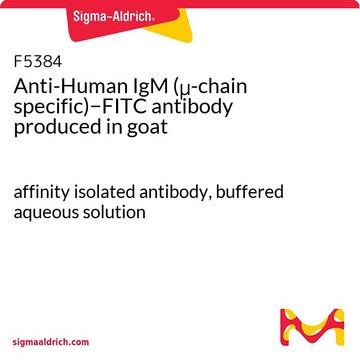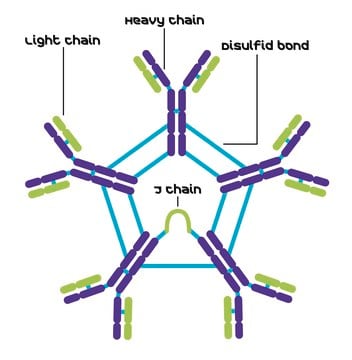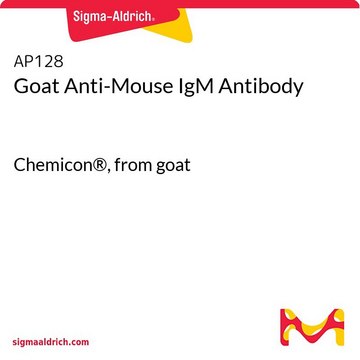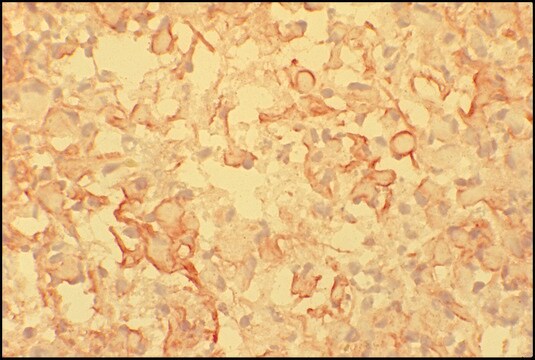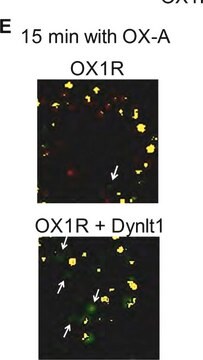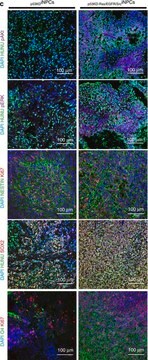F9259
Anti-Mouse IgM (μ-chain specific)–FITC antibody produced in goat
affinity isolated antibody, buffered aqueous solution
Synonym(e):
Mouse IgM antibody
Anmeldenzur Ansicht organisationsspezifischer und vertraglich vereinbarter Preise
Alle Fotos(1)
About This Item
Empfohlene Produkte
Biologische Quelle
goat
Konjugat
FITC conjugate
Antikörperform
affinity isolated antibody
Antikörper-Produkttyp
secondary antibodies
Klon
polyclonal
Form
buffered aqueous solution
Methode(n)
direct immunofluorescence: 1:128
Lagertemp.
2-8°C
Posttranslationale Modifikation Target
unmodified
Allgemeine Beschreibung
IgM antibodies are present as pentamers in the serum and are produced in response to antigens
Anti-Mouse IgM (μ-chain specific)-FITC antibody is specific for mouse IgM with mu chain. The antibody preparation is specific for mouse IgM when tested against purified mouse IgA, IgG (all subclasses), and IgM. Goat anti-mouse IgM is then conjugated to Fluorescein Isothiocyanate (FITC), Isomer I.
Anti-Mouse IgM (μ-chain specific)-FITC antibody is specific for mouse IgM with mu chain. The antibody preparation is specific for mouse IgM when tested against purified mouse IgA, IgG (all subclasses), and IgM. Goat anti-mouse IgM is then conjugated to Fluorescein Isothiocyanate (FITC), Isomer I.
Spezifität
Binds mouse IgM only; does not bind other mouse Igs.
Immunogen
Purified mouse IgM
Anwendung
Anti-Mouse IgM (μ-chain specific)-FITC antibody may be used for immunofluorescent labeling of mouse spleen cells at a minimum working antibody dilution of 1:128. It was also used for immunohistochemistry of rat heart tissue sections at a working dilution of 1:50. A dilution of 1:100 was used to label human ovarian-adenocarcinoma cells for immunofluorescence.
Applications in which this antibody has been used successfully, and the associated peer-reviewed papers, are given below.
Immunofluorescence (1 paper)
Immunofluorescence (1 paper)
Physikalische Form
Solution in 0.01 M phosphate buffered saline, pH 7.4, containing 1% bovine serum albumin and 15 mM sodium azide.
Haftungsausschluss
Unless otherwise stated in our catalog or other company documentation accompanying the product(s), our products are intended for research use only and are not to be used for any other purpose, which includes but is not limited to, unauthorized commercial uses, in vitro diagnostic uses, ex vivo or in vivo therapeutic uses or any type of consumption or application to humans or animals.
Sie haben nicht das passende Produkt gefunden?
Probieren Sie unser Produkt-Auswahlhilfe. aus.
Lagerklassenschlüssel
10 - Combustible liquids
WGK
WGK 3
Flammpunkt (°F)
Not applicable
Flammpunkt (°C)
Not applicable
Hier finden Sie alle aktuellen Versionen:
Besitzen Sie dieses Produkt bereits?
In der Dokumentenbibliothek finden Sie die Dokumentation zu den Produkten, die Sie kürzlich erworben haben.
Kunden haben sich ebenfalls angesehen
Bone marrow stromal cells improve cardiac performance in healed infarcted rat hearts
Olivares EL et al
American Journal of Physiology. Heart and Circulatory Physiology, 287, H646-H670 (2004)
F Carreiras et al.
International journal of cancer, 63(4), 530-536 (1995-11-15)
Accumulating evidence suggests that integrins, which participate in many complex cellular processes, are important for tumor progression and metastasis. In order to understand the role of these cell-surface receptors and of their ligands in the biological behavior of ovarian tumor
Saeed Abbasalizadeh et al.
Tissue engineering. Part C, Methods, 18(11), 831-851 (2012-05-09)
Current protocols for the scalable suspension culture of human pluripotent stem cells (hPSCs) are limited by multiple biological and technical challenges that need to be addressed before their use in clinical trials. To overcome these challenges, we have developed a
Michael P Storm et al.
Biotechnology and bioengineering, 107(4), 683-695 (2010-07-01)
Mouse embryonic stem cell (ESC) lines, and more recently human ESC lines, have become valuable tools for studying early mammalian development. Increasing interest in ESCs and their differentiated progeny in drug discovery and as potential therapeutic agents has highlighted the
Akt-mediated anti-apoptotic effects of substance P in Anti-Fas-induced apoptosis of human tenocytes.
Ludvig J Backman et al.
Journal of cellular and molecular medicine, 17(6), 723-733 (2013-04-13)
Substance P (SP) and its receptor, the neurokinin-1 receptor (NK-1 R), are expressed by human tenocytes, and they are both up-regulated in cases of tendinosis, a condition associated with excessive apoptosis. It is known that SP can phosphorylate/activate the protein
Unser Team von Wissenschaftlern verfügt über Erfahrung in allen Forschungsbereichen einschließlich Life Science, Materialwissenschaften, chemischer Synthese, Chromatographie, Analytik und vielen mehr..
Setzen Sie sich mit dem technischen Dienst in Verbindung.
